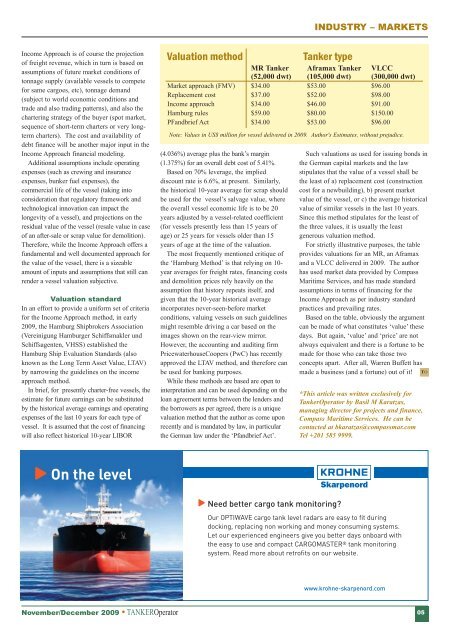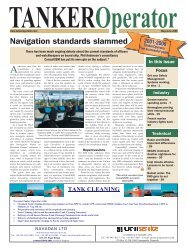Features: - Tanker Operator
Features: - Tanker Operator
Features: - Tanker Operator
You also want an ePaper? Increase the reach of your titles
YUMPU automatically turns print PDFs into web optimized ePapers that Google loves.
INDUSTRY – MARKETS<br />
Income Approach is of course the projection<br />
of freight revenue, which in turn is based on<br />
assumptions of future market conditions of<br />
tonnage supply (available vessels to compete<br />
for same cargoes, etc), tonnage demand<br />
(subject to world economic conditions and<br />
trade and also trading patterns), and also the<br />
chartering strategy of the buyer (spot market,<br />
sequence of short-term charters or very longterm<br />
charters). The cost and availability of<br />
debt finance will be another major input in the<br />
Income Approach financial modeling.<br />
Additional assumptions include operating<br />
expenses (such as crewing and insurance<br />
expenses, bunker fuel expenses), the<br />
commercial life of the vessel (taking into<br />
consideration that regulatory framework and<br />
technological innovation can impact the<br />
longevity of a vessel), and projections on the<br />
residual value of the vessel (resale value in case<br />
of an after-sale or scrap value for demolition).<br />
Therefore, while the Income Approach offers a<br />
fundamental and well documented approach for<br />
the value of the vessel, there is a sizeable<br />
amount of inputs and assumptions that still can<br />
render a vessel valuation subjective.<br />
Valuation standard<br />
In an effort to provide a uniform set of criteria<br />
for the Income Approach method, in early<br />
2009, the Hamburg Shipbrokers Association<br />
(Vereinigung Hamburger Schiffsmakler und<br />
Schiffsagenten, VHSS) established the<br />
Hamburg Ship Evaluation Standards (also<br />
known as the Long Term Asset Value, LTAV)<br />
by narrowing the guidelines on the income<br />
approach method.<br />
In brief, for presently charter-free vessels, the<br />
estimate for future earnings can be substituted<br />
by the historical average earnings and operating<br />
expenses of the last 10 years for each type of<br />
vessel. It is assumed that the cost of financing<br />
will also reflect historical 10-year LIBOR<br />
Valuation method<br />
(4.036%) average plus the bank’s margin<br />
(1.375%) for an overall debt cost of 5.41%.<br />
Based on 70% leverage, the implied<br />
discount rate is 6.6%, at present. Similarly,<br />
the historical 10-year average for scrap should<br />
be used for the vessel’s salvage value, where<br />
the overall vessel economic life is to be 20<br />
years adjusted by a vessel-related coefficient<br />
(for vessels presently less than 15 years of<br />
age) or 25 years for vessels older than 15<br />
years of age at the time of the valuation.<br />
The most frequently mentioned critique of<br />
the ‘Hamburg Method’ is that relying on 10-<br />
year averages for freight rates, financing costs<br />
and demolition prices rely heavily on the<br />
assumption that history repeats itself, and<br />
given that the 10-year historical average<br />
incorporates never-seen-before market<br />
conditions, valuing vessels on such guidelines<br />
might resemble driving a car based on the<br />
images shown on the rear-view mirror.<br />
However, the accounting and auditing firm<br />
PricewaterhouseCoopers (PwC) has recently<br />
approved the LTAV method, and therefore can<br />
be used for banking purposes.<br />
While these methods are based are open to<br />
interpretation and can be used depending on the<br />
loan agreement terms between the lenders and<br />
the borrowers as per agreed, there is a unique<br />
valuation method that the author as come upon<br />
recently and is mandated by law, in particular<br />
the German law under the ‘Pfandbrief Act’.<br />
<strong>Tanker</strong> type<br />
MR <strong>Tanker</strong> Aframax <strong>Tanker</strong> VLCC<br />
(52,000 dwt) (105,000 dwt) (300,000 dwt)<br />
Market approach (FMV) $34.00 $53.00 $96.00<br />
Replacement cost $37.00 $52.00 $98.00<br />
Income approach $34.00 $46.00 $91.00<br />
Hamburg rules $59.00 $80.00 $150.00<br />
PFandbrief Act $34.00 $53.00 $96.00<br />
ote: Values in US$ million for vessel delivered in 2009. Author's Estimates, without prejudice.<br />
Such valuations as used for issuing bonds in<br />
the German capital markets and the law<br />
stipulates that the value of a vessel shall be<br />
the least of a) replacement cost (construction<br />
cost for a newbuilding), b) present market<br />
value of the vessel, or c) the average historical<br />
value of similar vessels in the last 10 years.<br />
Since this method stipulates for the least of<br />
the three values, it is usually the least<br />
generous valuation method.<br />
For strictly illustrative purposes, the table<br />
provides valuations for an MR, an Aframax<br />
and a VLCC delivered in 2009. The author<br />
has used market data provided by Compass<br />
Maritime Services, and has made standard<br />
assumptions in terms of financing for the<br />
Income Approach as per industry standard<br />
practices and prevailing rates.<br />
Based on the table, obviously the argument<br />
can be made of what constitutes ‘value’ these<br />
days. But again, ‘value’ and ‘price’ are not<br />
always equivalent and there is a fortune to be<br />
made for those who can take those two<br />
concepts apart. After all, Warren Buffett has<br />
made a business (and a fortune) out of it! TO<br />
*This article was written exclusively for<br />
<strong>Tanker</strong><strong>Operator</strong> by Basil M Karatzas,<br />
managing director for projects and finance,<br />
Compass Maritime Services. He can be<br />
contacted at bkaratzas@compassmar.com<br />
Tel +201 585 9999.<br />
On the level<br />
Need better cargo tank monitoring?<br />
Our OPTIWAVE cargo tank level radars are easy to fit during<br />
docking, replacing non working and money consuming systems.<br />
Let our experienced engineers give you better days onboard with<br />
the easy to use and compact CARGOMASTER ® tank monitoring<br />
system. Read more about retrofits on our website.<br />
www.krohne-skarpenord.com<br />
November/December 2009 TANKER<strong>Operator</strong> 05

















